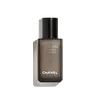What's inside
What's inside
 Key Ingredients
Key Ingredients

 Benefits
Benefits

 Concerns
Concerns

 Ingredients Side-by-side
Ingredients Side-by-side

Water
Skin ConditioningAlcohol
AntimicrobialGlycerin
HumectantPropanediol
SolventDimethicone
EmollientTriethylhexanoin
MaskingCamellia Kissi Seed Oil
EmollientButylene Glycol
HumectantCetearyl Alcohol
EmollientMethyl Methacrylate Crosspolymer
Ipomoea Batatas Root Extract
Skin ConditioningButyrospermum Parkii Butter
Skin ConditioningAmmonium Acryloyldimethyltaurate/Vp Copolymer
Dipropylene Glycol
HumectantPhenoxyethanol
PreservativeBoron Nitride
AbsorbentGlyceryl Stearate
EmollientPEG-100 Stearate
Tocopheryl Acetate
AntioxidantParfum
MaskingCetearyl Glucoside
EmulsifyingDimethicone Crosspolymer
Emulsion StabilisingCaprylyl Glycol
EmollientSorbitan Laurate
EmulsifyingXanthan Gum
EmulsifyingPropylene Glycol
HumectantHydrolyzed Silk
HumectantSodium Hyaluronate
HumectantHydroxyethylcellulose
Emulsion StabilisingAcetyl Dipeptide-1 Cetyl Ester
Skin ConditioningPhytic Acid
Sodium Benzoate
MaskingSodium Citrate
BufferingHydrochloric Acid
BufferingCitric Acid
BufferingTocopherol
AntioxidantPalmitoyl Oligopeptide
CleansingCI 14700
Cosmetic ColorantCI 19140
Cosmetic ColorantWater, Alcohol, Glycerin, Propanediol, Dimethicone, Triethylhexanoin, Camellia Kissi Seed Oil, Butylene Glycol, Cetearyl Alcohol, Methyl Methacrylate Crosspolymer, Ipomoea Batatas Root Extract, Butyrospermum Parkii Butter, Ammonium Acryloyldimethyltaurate/Vp Copolymer, Dipropylene Glycol, Phenoxyethanol, Boron Nitride, Glyceryl Stearate, PEG-100 Stearate, Tocopheryl Acetate, Parfum, Cetearyl Glucoside, Dimethicone Crosspolymer, Caprylyl Glycol, Sorbitan Laurate, Xanthan Gum, Propylene Glycol, Hydrolyzed Silk, Sodium Hyaluronate, Hydroxyethylcellulose, Acetyl Dipeptide-1 Cetyl Ester, Phytic Acid, Sodium Benzoate, Sodium Citrate, Hydrochloric Acid, Citric Acid, Tocopherol, Palmitoyl Oligopeptide, CI 14700, CI 19140
Water
Skin ConditioningAlcohol
AntimicrobialGlycerin
HumectantMel
EmollientPentylene Glycol
Skin ConditioningDiglycerin
HumectantCaesalpinia Spinosa Fruit Extract
Skin ProtectingSecale Cereale Seed Extract
AbrasiveCentella Asiatica Leaf Extract
Skin ConditioningKappaphycus Alvarezii Extract
Skin ConditioningTapioca Starch
Chlorphenesin
AntimicrobialCaprylyl Glycol
EmollientMaltooligosyl Glucoside
Skin ConditioningTremella Fuciformis Extract
HumectantSodium Hyaluronate
HumectantHydrogenated Starch Hydrolysate
HumectantCarbomer
Emulsion StabilisingPolyglycerin-3
HumectantAgar
MaskingXanthan Gum
EmulsifyingArginine
Masking1,2-Hexanediol
Skin ConditioningWater, Alcohol, Glycerin, Mel, Pentylene Glycol, Diglycerin, Caesalpinia Spinosa Fruit Extract, Secale Cereale Seed Extract, Centella Asiatica Leaf Extract, Kappaphycus Alvarezii Extract, Tapioca Starch, Chlorphenesin, Caprylyl Glycol, Maltooligosyl Glucoside, Tremella Fuciformis Extract, Sodium Hyaluronate, Hydrogenated Starch Hydrolysate, Carbomer, Polyglycerin-3, Agar, Xanthan Gum, Arginine, 1,2-Hexanediol
Ingredients Explained
These ingredients are found in both products.
Ingredients higher up in an ingredient list are typically present in a larger amount.
Alcohol comes in many different forms. Different types of alcohol will have different effects on skin. This ingredient is usually an astringent alcohol.
These alcohols are drying on the skin. They may strip away your skin's natural oils and even damage your skin barrier. Astringent alcohols may also irritate skin.
Other types of astringent alcohols include:
According to the National Rosacea Society based in the US, you should be mindful of products with these alcohols in the top half of ingredients.
Any type of sanitizing product will have high amounts of alcohol to help kill bacteria and viruses.
Fatty alcohols come from plant oils such as coconut oil. These can help hydrate the skin and are non-irritating. Some fatty alcohols include cetyl and stearyl alcohol.
Learn more about AlcoholCaprylyl Glycol is a humectant and emollient, meaning it attracts and preserves moisture.
It is a common ingredient in many products, especially those designed to hydrate skin. The primary benefits are retaining moisture, skin softening, and promoting a healthy skin barrier.
Though Caprylyl Glycol is an alcohol derived from fatty acids, it is not the kind that can dry out skin.
This ingredient is also used as a preservative to extend the life of products. It has slight antimicrobial properties.
Learn more about Caprylyl GlycolGlycerin is already naturally found in your skin. It helps moisturize and protect your skin.
A study from 2016 found glycerin to be more effective as a humectant than AHAs and hyaluronic acid.
As a humectant, it helps the skin stay hydrated by pulling moisture to your skin. The low molecular weight of glycerin allows it to pull moisture into the deeper layers of your skin.
Hydrated skin improves your skin barrier; Your skin barrier helps protect against irritants and bacteria.
Glycerin has also been found to have antimicrobial and antiviral properties. Due to these properties, glycerin is often used in wound and burn treatments.
In cosmetics, glycerin is usually derived from plants such as soybean or palm. However, it can also be sourced from animals, such as tallow or animal fat.
This ingredient is organic, colorless, odorless, and non-toxic.
Glycerin is the name for this ingredient in American English. British English uses Glycerol/Glycerine.
Learn more about GlycerinSodium Hyaluronate is hyaluronic acid's salt form. It is commonly derived from the sodium salt of hyaluronic acid.
Like hyaluronic acid, it is great at holding water and acts as a humectant. This makes it a great skin hydrating ingredient.
Sodium Hyaluronate is naturally occurring in our bodies and is mostly found in eye fluid and joints.
These are some other common types of Hyaluronic Acid:
Learn more about Sodium HyaluronateWater. It's the most common cosmetic ingredient of all. You'll usually see it at the top of ingredient lists, meaning that it makes up the largest part of the product.
So why is it so popular? Water most often acts as a solvent - this means that it helps dissolve other ingredients into the formulation.
You'll also recognize water as that liquid we all need to stay alive. If you see this, drink a glass of water. Stay hydrated!
Learn more about WaterXanthan gum is used as a stabilizer and thickener within cosmetic products. It helps give products a sticky, thick feeling - preventing them from being too runny.
On the technical side of things, xanthan gum is a polysaccharide - a combination consisting of multiple sugar molecules bonded together.
Xanthan gum is a pretty common and great ingredient. It is a natural, non-toxic, non-irritating ingredient that is also commonly used in food products.
Learn more about Xanthan Gum